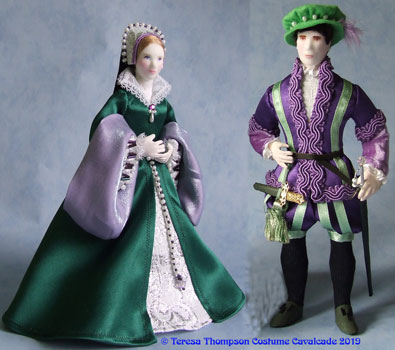.jpg)
The Lady in Court Dress wears a gown with low square neckline to the stiff bodice and elaborate sleeves. Her headdress is known as the 'gable' and was only ever worn in England. You can see it represented on any deck of playing cards today as worn by the Queens.
The Gentleman wears many layers of clothes that add to his bulk. The result is probably the most aggressively masculine costume ever worn.

The Lady wears a hooped petticoat for the first time. It was known as the Spanish farthingale and gave a formal cone shape to the skirts.
The Gentleman looks a little slimmer, having lost some of his layers, but because his breeches are now on show they have to be decorated with 'panes' - strips of fabric laid over a lining.

The Lady in Court Dress has skirts supported by the French farthingale, which gives them a drum shape. Her bodice has a long point at the front that rests on top of her skirts. Her fan is new and probably made necessary by the bulk of her clothes.
The Gentleman wears short, padded breeches and doublet with 'peascod belly'. A short Spanish cloak is worn over one shoulder and a tall crowned hat set a a rakish angle on his head.
There is no other period in history where the shape of the human figure was so much distorted as this.